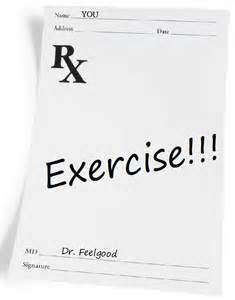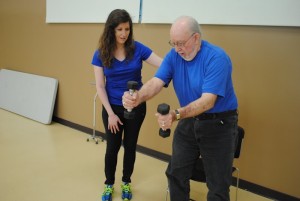Need a ‘No Excuse’ Approach To Exercise?
What do the following items have in common? Alarm, Sunscreen, Exercise, Notes, Medication, Advice…
Lost your password? Please enter your email address. You will receive a link to create a new password.

What do the following items have in common? Alarm, Sunscreen, Exercise, Notes, Medication, Advice…

With the recent push for getting everybody moving, for some, Health Screening, Exercise Testing, Exercise Prescription as well as Fitness Programming are all areas where professional guidance may be necessary. The knowledge and experience of multiple Healthcare and Fitness Professionals combined provides a holistic approach for a lifetime of optimal health and well-being.

Kinesiotherapy (KT) is a highly specialized and yet extremely adaptable therapeutic discipline. A Registered Kinesiotherapist (RKT) is equipped with knowledge and skills to bridge any gap between acute illness and physical wellness. The RKT uses two fundamental modalities, exercise and education, to help improve functional loss in their clients.

Okay Isaac Newton, I think you were on to something here… according to your brilliant first law of physics, things will generally just keep doing what they are doing i.e.) either rest or move. This law can even be applied to the overall trend of our bodies; we are either generally at rest or generally in motion.
Alone in a Las Vegas hotel room, it happened – a turning point in one’s life that suddenly changes everything forever.
Ray, a 73-year-old retiree, was having a stroke. From his pre-med studies he knew what was happening and what needed to be done. Crawling to the phone, Ray spoke with the front desk staff and requested emergency personnel. When the paramedics arrived, he instructed them on procedure. Later Ray would learn that his stroke was hemorrhagic and had missed the speech portion of his brain by mere centimeters.
After completing physical therapy at St. Jude’s Hospital in Fullerton, CA, Ray wanted to continue exercise therapy. He knew what physical movement had done for him – he felt strong, healthy, and functionally fit. However, at the completion of his program, Ray was turned away. He kept returning, requesting additional exercise therapy, but was told his time there for over because his insurance reached its maximum. Discouraged, Ray found himself in a parking lot where he spotted a business card. The card had the logo for a local community center. Ray called the number and was pleasantly surprised to learn that the center had a personal training staff that worked with clients who survived medical catastrophes, such as strokes and heart attacks.
Ray and I first met in July 2011. He drove a specially designed car and walked with a cane as well as a brace on his leg. One half of his body was rendered completely paralyzed from the stroke. Ray’s gait was extremely slow and he could only walk for a few moments at a time before stopping to rest.
At that initial meeting, I tested Ray’s strength by giving him a light free weight to lift. As he attempted a shoulder press, his left hand shook uncontrollably. For the first several months, Ray and I worked together privately. As the room we were working in was a children’s classroom that contained many toys, we used whatever props were available to improve Ray’s fitness level. Sometimes, I would utilize other objects, such as a small stress ball. We started with basic hand exercises, such as ball squeezes. To improve fine motor skills, Ray picked up small objects with his fingers. As Ray’s motor skills increased, the objects became smaller and smaller, until they were plastic-wrapped caramel candies. Ray reached the point where he was able to unwrap the candies with no assistance.
 Our exercises also involved hand-eye coordination, such as tossing and catching an under-inflated ball to each other, as I kept running to different parts of the room so that Ray was challenged to located me and then throw the ball in my direction. We also used the under-inflated ball with Ray in a seated position, as he placed the ball between his ankles and lifted it with his legs. Ray was also able to perform basic strength training exercises with free weights, such as bicep curls, hammer curls and chest flys. He was getting stronger and was now able to remove his leg brace and walk for short periods of time. I was amazed at what I was seeing.
Our exercises also involved hand-eye coordination, such as tossing and catching an under-inflated ball to each other, as I kept running to different parts of the room so that Ray was challenged to located me and then throw the ball in my direction. We also used the under-inflated ball with Ray in a seated position, as he placed the ball between his ankles and lifted it with his legs. Ray was also able to perform basic strength training exercises with free weights, such as bicep curls, hammer curls and chest flys. He was getting stronger and was now able to remove his leg brace and walk for short periods of time. I was amazed at what I was seeing.
After several months, Ray astounded the members when he graduated to the main gym floor and started working out on the machines with the general population. He was now performing leg presses, chest presses, hamstring curls, abdominal curls, lat pull-downs, back extensions, tricep and inner/outer thigh exercises. Ray’s gait had improved tremendously and he now walked all the way into the gym with substantially reduced rest periods.
We were ecstatic on the day Ray had feeling on his paralyzed side for the first time in years. This was a historic milestone and demonstrated the power of healing. Everyone who had seen Ray in his early days were inspired and uplifted as they witnessed a truly remarkable transformation.
IDEA Fitness Journal featured Ray’s story in its November/December 2012 issue.
Ray discovered us by Divine intervention, since physical therapists and allied health personnel do not currently refer patients to Certified Personal Trainers.
Certified Personal Trainers, like many professions, encompass a wide array of specialties. Most people think of us working with the general population, devising exercise programs with goals of weight loss, toning and body building. They know us through aquatics classes, Zumba, yoga, boot camp and Pilates.
What most people do not know is that a significant portion of our client base are actually medical patients who have survived strokes, cancer, heart attacks, polio, joint replacement, Muscular Dystrophy, electrocution, fatty liver disease, diabetes, and lesser known genetic diseases such as Charcot-Marie-Tooth Disease.
Since 2007, the vast majority of my clients have been in this category. With the Baby Boomer generation entering retirement, these trends will continue well into the future. And as the fitness industry moves toward regulation, requiring mandatory certification or professional license, we look forward to the day when we take our rightful place in the healthcare continuum, providing patients with ongoing exercise therapy long after physical therapy is completed. In this way,
clients like Ray, whether mobile or homebound, will receive desperately needed services.
We do not know yet if our titles will be Licensed Fitness Trainer (LFT), Licensed Personal Trainer (LPT), or Licensed Fitness Professional (LFP). No matter what, we will continue to provide necessary and ongoing services to patients who need us the most. Through the Medical Fitness Network, we hope to reach this greatly under-served population. I believe that Ray’s transformation is a miracle. Body, mind and spirit are healed and every day hope springs eternal.
About Julia
 With a degree in Mass Communications/Broadcast Journalism, Julia has written for national magazines, interviewing actors Tony Danza (Who’s the Boss?), Joe Mantegna (“Criminal Minds”) and Paul Sorvino (“Law & Order”). Julia has written restaurant reviews, cookbook reviews, professional biographies, award show brochures, press releases and promotional pieces. She edited the book “Helping Hilda,” and has written educational columns for a dentist and chiropractor. In the voice industry, Julia narrated books on tape, on-hold voice messaging systems, radio sound bites, and cable television. Her degree in Broadcast Journalism allows her to write scripts as well as narrate them.
With a degree in Mass Communications/Broadcast Journalism, Julia has written for national magazines, interviewing actors Tony Danza (Who’s the Boss?), Joe Mantegna (“Criminal Minds”) and Paul Sorvino (“Law & Order”). Julia has written restaurant reviews, cookbook reviews, professional biographies, award show brochures, press releases and promotional pieces. She edited the book “Helping Hilda,” and has written educational columns for a dentist and chiropractor. In the voice industry, Julia narrated books on tape, on-hold voice messaging systems, radio sound bites, and cable television. Her degree in Broadcast Journalism allows her to write scripts as well as narrate them.
Julia started running in 1997 and completed her first marathon in 2000. While spending many hours in several gyms, fellow members approached her with exercise training questions, which convinced Julia to become certified. After much research, Julia chose the American Council on Exercise as her certifying organization, and obtained her ACE Certified Personal Trainer designation in 2006.
Immediately, the Facilities Supervisor for the City of San Dimas called and asked if Julia would develop the city’s first Strength Training Class for seniors. She did, and in 2007 “Strength Training Fundamentals for Seniors,” began, launching her into group fitness right out of the gate. The class, comprised of active, inspired and motivated seniors, was an eye-opener into the generation that survived the Great Depression and would try virtually any exercise until mastering it. The class was so popular that residents were requesting that it be opened to the 30-54 age groups as well.
In 2008, Julia officially earned her ACE- Group Fitness Instructor designation and continued on to provide exercise training services for all ages, in community centers, privately in clients’ homes, and in women’s gyms. Julia has worked with “Medical Fitness” clients more than any other group. They have survived the following medical conditions: Stroke, heart attack, cancer, polio, obesity, Muscular Dystrophy, electrocution, Charcot-Marie-Tooth Disease, Hypertension, Diabetes, Fatty Liver Disease, joint replacement, post-physical therapy patients and more.
“What is incredibly satisfying about working in this field is starting with a client who is severely limited and watching the transformative power of exercise,” she says. Her client, Ray, found amazing success. “Ray had suffered a hemorrhagic stroke and could barely walk. The left half of his body was completely paralyzed. In the beginning, he and I worked in a private room with basic exercises. Ray’s stride improved; his strength and endurance increased. Over time, Ray advanced to the main gym with the general population, who were blown away by his astounding transformation. Ray had feeling on his paralyzed side for the first time in years!”
In the United States more than 700,000 people suffer a stroke each year. Approximately 2/3 of these individuals survive the cerebral vascular accident and require rehabilitation (relearn skills that are lost when part of the brain is damaged). The goals of rehabilitation are to help survivors become as independent as possible and to attain the best possible quality of life.
Physical therapists specialize in treating disabilities related to motor and sensory impairments. They are trained in all aspects of anatomy and physiology related to normal function, with an emphasis on movement. They assess the patient’s strength, endurance, range of motion, gait abnormalities and sensory deficits to design individualized rehabilitation programs aimed at regaining control over motor functions.
impairments. They are trained in all aspects of anatomy and physiology related to normal function, with an emphasis on movement. They assess the patient’s strength, endurance, range of motion, gait abnormalities and sensory deficits to design individualized rehabilitation programs aimed at regaining control over motor functions.
Functions compromised when a specific region of the brain is damaged by stroke can sometimes be taken over by other parts of the brain. This ability to adapt and change is known as neuroplasticity. Physical therapists help the patient regain the use of stroke-impaired limbs, teach compensatory strategies to reduce the effect of remaining deficits and establish ongoing exercise programs to help people retain their newly learned skills. The repetitive use of impaired limbs encourages brain plasticity!
In general, physical therapy emphasizes practicing isolated movements, repeatedly changing from one kind of movement to another and rehearsing complex movements that require a great deal of coordination and balance. Balance retraining may consist of walking up or down stairs or moving safely between obstacles. People too weak to bear their own weight can still practice repetitive movements during hydrotherapy (water providing a sensory stimulation and allowing for weight support) or while being partially supported by a harness. A recent trend in physical therapy emphasizes the effectiveness of engaging in goal-directed activities, such as playing games, to promote coordination, balance and movement strategies.
If you or your loved one has had a stroke, be sure to be evaluated by a physical therapist as they can substantially help people achieve the best possible long-term outcome.

Dietitians can help people who have had a stroke or are at risk for cerebrovascular disease understand and implement dietary practices to control blood pressure, cholesterol levels, and lower the risk for having a second event.